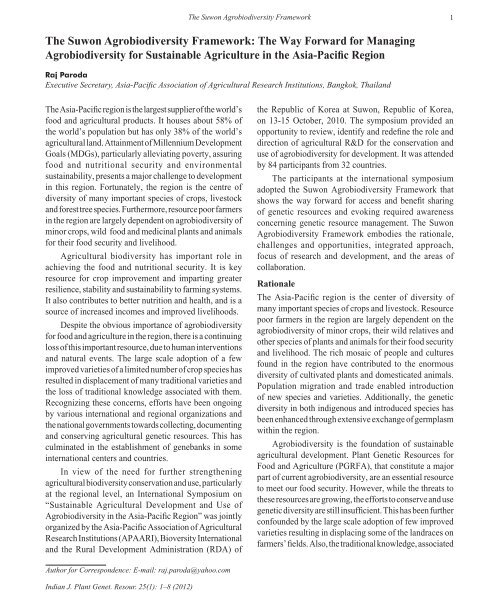indian society of plant genetic resources - Bioversity International
indian society of plant genetic resources - Bioversity International
indian society of plant genetic resources - Bioversity International
Create successful ePaper yourself
Turn your PDF publications into a flip-book with our unique Google optimized e-Paper software.
Indian J. Plant Genet. Resour. 25(1): 1–8 (2012)<br />
The Suwon Agrobiodiversity Framework 1<br />
The Suwon Agrobiodiversity Framework: The Way Forward for Managing<br />
Agrobiodiversity for Sustainable Agriculture in the Asia-Pacifi c Region<br />
Raj Paroda<br />
Executive Secretary, Asia-Pacifi c Association <strong>of</strong> Agricultural Research Institutions, Bangkok, Thailand<br />
The Asia-Pacifi c region is the largest supplier <strong>of</strong> the world’s<br />
food and agricultural products. It houses about 58% <strong>of</strong><br />
the world’s population but has only 38% <strong>of</strong> the world’s<br />
agricultural land. Attainment <strong>of</strong> Millennium Development<br />
Goals (MDGs), particularly alleviating poverty, assuring<br />
food and nutritional security and environmental<br />
sustainability, presents a major challenge to development<br />
in this region. Fortunately, the region is the centre <strong>of</strong><br />
diversity <strong>of</strong> many important species <strong>of</strong> crops, livestock<br />
and forest tree species. Furthermore, resource poor farmers<br />
in the region are largely dependent on agrobiodiversity <strong>of</strong><br />
minor crops, wild food and medicinal <strong>plant</strong>s and animals<br />
for their food security and livelihood.<br />
Agricultural biodiversity has important role in<br />
achieving the food and nutritional security. It is key<br />
resource for crop improvement and imparting greater<br />
resilience, stability and sustainability to farming systems.<br />
It also contributes to better nutrition and health, and is a<br />
source <strong>of</strong> increased incomes and improved livelihoods.<br />
Despite the obvious importance <strong>of</strong> agrobiodiversity<br />
for food and agriculture in the region, there is a continuing<br />
loss <strong>of</strong> this important resource, due to human interventions<br />
and natural events. The large scale adoption <strong>of</strong> a few<br />
improved varieties <strong>of</strong> a limited number <strong>of</strong> crop species has<br />
resulted in displacement <strong>of</strong> many traditional varieties and<br />
the loss <strong>of</strong> traditional knowledge associated with them.<br />
Recognizing these concerns, efforts have been ongoing<br />
by various international and regional organizations and<br />
the national governments towards collecting, documenting<br />
and conserving agricultural <strong>genetic</strong> <strong>resources</strong>. This has<br />
culminated in the establishment <strong>of</strong> genebanks in some<br />
international centers and countries.<br />
In view <strong>of</strong> the need for further strengthening<br />
agricultural biodiversity conservation and use, particularly<br />
at the regional level, an <strong>International</strong> Symposium on<br />
“Sustainable Agricultural Development and Use <strong>of</strong><br />
Agrobiodiversity in the Asia-Pacifi c Region” was jointly<br />
organized by the Asia-Pacifi c Association <strong>of</strong> Agricultural<br />
Research Institutions (APAARI), <strong>Bioversity</strong> <strong>International</strong><br />
and the Rural Development Administration (RDA) <strong>of</strong><br />
Author for Correspondence: E-mail: raj.paroda@yahoo.com<br />
the Republic <strong>of</strong> Korea at Suwon, Republic <strong>of</strong> Korea,<br />
on 13-15 October, 2010. The symposium provided an<br />
opportunity to review, identify and redefi ne the role and<br />
direction <strong>of</strong> agricultural R&D for the conservation and<br />
use <strong>of</strong> agrobiodiversity for development. It was attended<br />
by 84 participants from 32 countries.<br />
The participants at the international symposium<br />
adopted the Suwon Agrobiodiversity Framework that<br />
shows the way forward for access and benefi t sharing<br />
<strong>of</strong> <strong>genetic</strong> <strong>resources</strong> and evoking required awareness<br />
concerning <strong>genetic</strong> resource management. The Suwon<br />
Agrobiodiversity Framework embodies the rationale,<br />
challenges and opportunities, integrated approach,<br />
focus <strong>of</strong> research and development, and the areas <strong>of</strong><br />
collaboration.<br />
Rationale<br />
The Asia-Pacifi c region is the center <strong>of</strong> diversity <strong>of</strong><br />
many important species <strong>of</strong> crops and livestock. Resource<br />
poor farmers in the region are largely dependent on the<br />
agrobiodiversity <strong>of</strong> minor crops, their wild relatives and<br />
other species <strong>of</strong> <strong>plant</strong>s and animals for their food security<br />
and livelihood. The rich mosaic <strong>of</strong> people and cultures<br />
found in the region have contributed to the enormous<br />
diversity <strong>of</strong> cultivated <strong>plant</strong>s and domesticated animals.<br />
Population migration and trade enabled introduction<br />
<strong>of</strong> new species and varieties. Additionally, the <strong>genetic</strong><br />
diversity in both indigenous and introduced species has<br />
been enhanced through extensive exchange <strong>of</strong> germplasm<br />
within the region.<br />
Agrobiodiversity is the foundation <strong>of</strong> sustainable<br />
agricultural development. Plant Genetic Resources for<br />
Food and Agriculture (PGRFA), that constitute a major<br />
part <strong>of</strong> current agrobiodiversity, are an essential resource<br />
to meet our food security. However, while the threats to<br />
these <strong>resources</strong> are growing, the efforts to conserve and use<br />
<strong>genetic</strong> diversity are still insuffi cient. This has been further<br />
confounded by the large scale adoption <strong>of</strong> few improved<br />
varieties resulting in displacing some <strong>of</strong> the landraces on<br />
farmers’ fi elds. Also, the traditional knowledge, associated

















